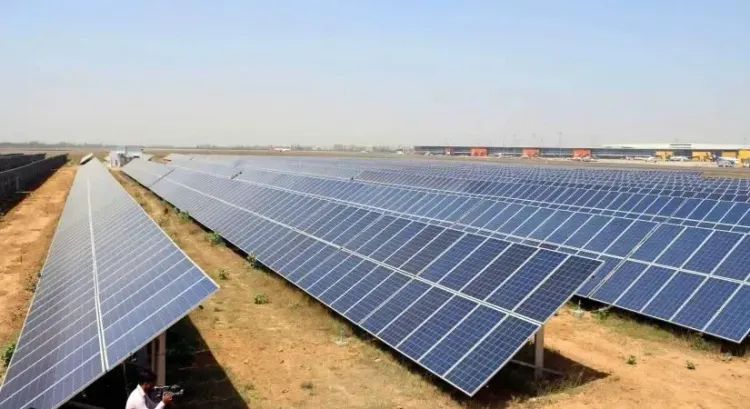Is India’s Solar Surge a Bold Leap Towards a Net Zero Future?

Synopsis
Key Takeaways
- India is the 3rd-largest solar energy producer globally.
- The country aims for 500 GW of clean energy by 2030.
- Renewables now account for over 50% of India's electricity generation.
- Government schemes are essential for promoting solar energy adoption.
- India's solar manufacturing capacity has nearly doubled.
New Delhi, Aug 19 (NationPress) India has emerged as the world’s 3rd-largest solar energy producer, having doubled its solar manufacturing capacity and achieved its COP26 renewable energy target five years ahead of its Paris agreement timeline. Renewables now account for over 50 percent of the nation’s total installed electricity generation capacity of 484.82 GW.
After surpassing 100 GW of solar power, India is poised to reach 500 GW of clean energy by 2030 and aims for net-zero emissions by 2070. Initiatives like large solar parks, rooftop solar systems, and the PM Surya Ghar Muft Bijli Yojana are empowering households to achieve energy independence.
The past decade of India’s energy evolution represents a strategic pivot towards self-sufficiency, sustainability, and innovation. From green hydrogen to solar rooftops, and from rural electrification to digital procurement, each initiative emphasizes India’s vision of inclusive, secure, and clean energy for all. As the country progresses, its balanced and forward-thinking energy strategy continues to fuel both economic growth and a sustainable future.
India now ranks 4th globally in Renewable Energy Installed Capacity, 4th in Wind Power, and 3rd in Solar Power capacity. The solar module manufacturing capacity in India surged from 38 GW to 74 GW during FY 2024-25.
Just a decade ago, India’s solar landscape was still in its early stages, with panels found only on a few rooftops and in deserts. Today, the nation has made remarkable progress, officially overtaking Japan to become the world’s third-largest solar power producer. According to the International Renewable Energy Agency (IRENA), India generated an impressive 1,08,494 GWh of solar energy, surpassing Japan’s 96,459 GWh.
As of July 2025, India’s cumulative solar power capacity reached 119.02 GW, comprising 90.99 GW from ground-mounted solar plants, 19.88 GW from grid-connected rooftop systems, 3.06 GW from hybrid projects, and 5.09 GW from off-grid solar installations, showcasing a diverse approach to renewable energy expansion.
India’s advancements in the renewable energy sector are a testament to the country’s focused policies and strategic planning. Prime Minister Narendra Modi has propelled the initiative forward, stating that “Green Future, Net Zero aren’t just fancy words but reflect India's need and commitment, making it the best destination for investment and innovation in renewable energy.”
Geographically, India benefits from its position in the tropical region, with the Tropic of Cancer crossing numerous states, which contributes to a high potential for solar power generation. The total potential for the solar sector in India is 748 GW. States and Union Territories such as Rajasthan, Jammu and Kashmir, Maharashtra, Madhya Pradesh, and Andhra Pradesh are pivotal in driving the country’s clean energy growth.
Regionally, the states with the most solar potential include Northern and Western Rajasthan, Southern Gujarat, Central Karnataka, Tamil Nadu, Andhra Pradesh, and Eastern and Other Maharashtra, Chhattisgarh, Odisha.
By July 2025, India’s solar power capacity had surged by 4,000 percent, with total renewable energy capacity reaching 227 GW. Palli village in Jammu and Kashmir emerged as a remarkable example, becoming India’s first carbon-neutral panchayat powered entirely by solar energy. There is a strong emphasis on the necessity for energy storage and the adoption of new technologies to fulfill future energy demands. Government initiatives like the PM Surya Ghar Yojana and PM Kusum Yojana are essential in assisting households and farmers in transitioning to clean solar energy.
The solar manufacturing sector in India encompasses key components such as solar modules, solar PV cells, and ingots and wafers. Producing these components domestically supports the local economy and decreases dependency on imports. In just one year, solar module manufacturing capacity nearly doubled—from 38 GW in March 2024 to 74 GW in March 2025. Similarly, solar PV cell production rose from 9 GW to 25 GW. A significant milestone was the establishment of India’s first ingot-wafer manufacturing facility (2 GW), further strengthening the entire solar supply chain.
This swift growth in domestic capacity is strongly backed by government policies. To encourage Indian-made solar products, it has become mandatory for projects under schemes like the Rooftop Solar Programme, PM-KUSUM, and CPSU Scheme Phase II to utilize panels and cells manufactured in India. To enhance this shift, a Basic Customs Duty was implemented in April 2022 on imported solar cells and modules. This policy makes imports more costly and promotes the use of Indian alternatives—boosting local manufacturing and reducing reliance on foreign suppliers.









